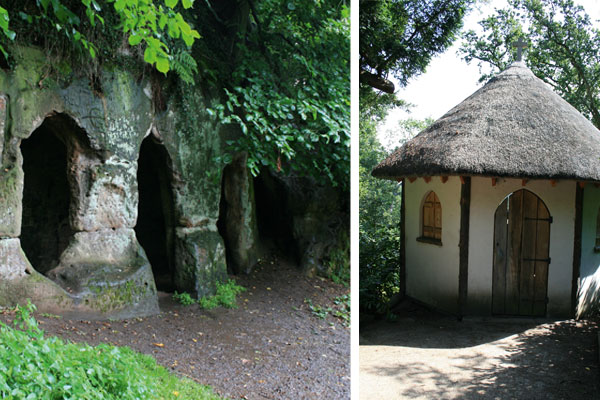In his 1780 essay On Modern Gardening Horace Walpole declared that of the many ornamental features then fashionable, the one ‘whose merit soonest fades’ was the hermitage. Inspired by the ancient cells of genuine religious anchorites, but largely decorative, garden hermitages had flourished in Britain during the 18th century. While some were appropriately primitive in design, others had Gothick doorways and windows filled with stained glass, floors made of pebbles or sheep’s knucklebones arranged in elaborate patterns, ceilings ornamented with pine cones, rustic furniture made from elm boles ‘distorted by fungal disease’, and inscriptions carved in stone to aid philosophical reflection.
Walpole may have found it ‘almost comic to set aside a quarter of one’s garden to be melancholic in’, but this had suited the sensibility of the age. Withdrawing from the world, if only to spend the afternoon in enjoyably gloomy reflection before returning to the main house for a proper dinner, held huge appeal in an age during which Milton’s ‘Il Penseroso’ had become a literary touchstone. In addition, buildings imitating caves or made of rubble or tree roots suited the picturesque gardening tastes of the period. Formal gardens, with their elaborate parterres and topiary, had become associated with absolute (and foreign) rulers, such as Louis XIV at Versailles, whereas ‘the English style’ saw gardens liberated from horticultural ‘tyranny’. As Alexander Pope put it, ‘the amiable simplicity of unadorned nature… spreads over the mind a more noble sort of tranquility’.
Creating a hermitage was one thing; finding a hermit to live in it quite another. During his researches for this succinct and fascinating history, Gordon Campbell came across reports of landowners placing advertisements in periodicals for men prepared to grow their beards and nails, adopt traditional eremitical garb and a frugal diet, and live in solitary contemplation at the bottom of the garden. He treats such adverts with healthy scepticism, but some gardens did indeed employ people as hermits. Elsewhere owners filled the role themselves rather in the manner of Marie Antoinette playing at being a dairymaid at the Hameau. Gilbert White persuaded his younger brother, the Reverend Henry White, to exchange his cassock for an anchorite’s costume when visitors were due at his Hampshire garden, and an engraving of this playful charade decorates the title-page of The Natural History of Selborne.
The difficulty of sourcing live hermits and the rise of abolitionism — against which the whole notion of keeping a man in strategically reduced circumstances in order to entertain one’s guests began to look questionable — led to a decline in this fanciful practice. Some people installed ‘stuffed’ hermits (in fact life-size models or automatons), while others artfully arranged props — a skull, an hour-glass, some books and a pair of spectacles — to suggest that a resident hermit had just popped out for a moment. For Campbell the hermitage built at Bicton House in Devon in 1839 ‘marks the point at which the garden hermitage ceased to gesture towards sombre reflection or even to accommodate a hermit, and instead became an elegant garden building that looked back towards a romantic age’.
In fact the distinction between hermitages and other garden pavilions had never been very clear. As early as 1767 William Wighte’s Grotesque Architecture or Rural Amusement: Consisting of Plans, Elevations, and Sections for Huts, Retreats, Summer and Winter Hermitages provided plans for seven different types of hermitage, including an ‘Oriental’ one ‘with an inscription in faux-Arabic script’ and an ‘Augustine’ one ‘with wings that end in pavilions to accommodate a library and a bath’ — not perhaps the sort of accommodation in which one would expect to encounter a genuine ascetic. Indeed, although Campbell writes very interestingly about ‘the idea of the hermit’, his book is as much about garden ornament — ending with the suggestion that garden gnomes (first introduced from Germany in 1840s) ‘came to occupy the cultural void occasioned by the demise of the ornamental hermit’.
The vogue for hermits — or at any rate hermitages — in the garden was comparatively short-lived, but it was remarkably widespread in the British Isles, with Ireland and Scotland boasting some particularly fine examples. Amongst other things, Campbell’s generously illustrated book is a descriptive gazetteer, and it usefully includes a catalogue of buildings that have survived or been lost. Although scholarly, it is written in a relaxed, non-academic style and is enlivened by a nicely dry humour.






Comments